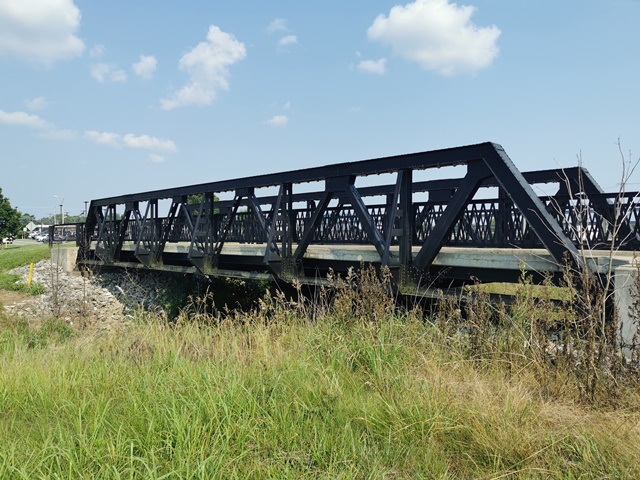We Recommend:
Bach Steel - Experts at historic truss bridge restoration.
BridgeHunter.com Phase 1 is released to the public! - Visit Now
Westview Drive Sidewalk Bridge
Canary Ditch Bridge

Primary Photographer(s): Nathan Holth
Bridge Documented: May 22, 2021
Franklin: Johnson County, Indiana: United States
1928 By Builder/Contractor: Unknown and Engineer/Design: Indiana State Highway Commission
2010
70.3 Feet (21.4 Meters)
72.0 Feet (21.9 Meters)
18.8 Feet (5.73 Meters)
1 Main Span(s)
Not Applicable

View Information About HSR Ratings
Bridge Documentation
This state standard pony truss was relocated and preserved for pedestrian use on a sidewalk. While the setting in a shopping area might not be the most scenic, it does expose this historic bridge to people who might otherwise not come in contact with historic bridges. To this end, it would be nice to see some interpretive signage added to expain the design and history of this bridge to visitors.
Due to the lack of interpretive signage, the exact history of this bridge is unclear. Tony Dillon, a reliable source on bridgehunter.com, suggests this bridge is most likely the Whetstine Road Bridge (Morgan County Bridge 31) and so HistoricBridges.org has operated on this assumption in providing a circa construction date, a circa rehabilitation/relocation date of 1910, and the given bridge dimensions.
Information and Findings From DHPA Historic Bridge Survey (For Morgan County Bridge #31)Bridge History and Significance The Indiana Department of Highways continued to design riveted Warren pony trusses throughout the 1930s for some spans requiring spans of less than 100 feet. The bridge trusses are half-hip, each with six panels and bolted together in three sections. Its diagonals are heavier at the end-posts than towards center span. They are made from two pairs of angles and battens for each outer panel and a single, increasingly lighter pair towards mid-span. The lower-chord members are also varied in size, each being fabricated from a pair of angles and battens in the outermost panel and with two pairs of angles for the inner panels. The verticals consist of two pairs of angles riveted together with several batten plates shared with the external braces. The battens integrate the sway bracing with the verticals. The I floor-beams are bolted to gussets and the verticals above the lower chord and carry a concrete deck with an asphalt roadway. Guardrails of light channels protect the trusses. The design of this structure follows ISHC patterns used in the transition between the mid-1920s and the mid-1930s. Although the deck is not as wide as typical of the 1930s, the method and amount of reinforcing used with some diagonal and lower chord members suggests the early years of the later decade. The combination of bolting and riveting in the superstructure suggests relocation. References Associated Engineering Consultants, Inc., Bridge Inventory Rating and Safety Inspection Report: Morgan County; Bridge Reinspection Study and Report: Morgan County (Nashville, 1974, 1978). Sebree, Craig, & McKneight, Inc., Bridge Reinspection Study and Report: Morgan County (Indianapolis, 1986). Bridge Considered Historic By Survey: Yes |
![]()
Photo Galleries and Videos: Westview Drive Sidewalk Bridge
Bridge Photo-Documentation
Original / Full Size PhotosA collection of overview and detail photos. This gallery offers photos in the highest available resolution and file size in a touch-friendly popup viewer.
Alternatively, Browse Without Using Viewer
![]()
Bridge Photo-Documentation
Mobile Optimized PhotosA collection of overview and detail photos. This gallery features data-friendly, fast-loading photos in a touch-friendly popup viewer.
Alternatively, Browse Without Using Viewer
![]()
Maps and Links: Westview Drive Sidewalk Bridge
Coordinates (Latitude, Longitude):
Search For Additional Bridge Listings:
Bridgehunter.com: View listed bridges within 0.5 miles (0.8 kilometers) of this bridge.
Bridgehunter.com: View listed bridges within 10 miles (16 kilometers) of this bridge.
Additional Maps:
Google Streetview (If Available)
GeoHack (Additional Links and Coordinates)
Apple Maps (Via DuckDuckGo Search)
Apple Maps (Apple devices only)
Android: Open Location In Your Map or GPS App
Flickr Gallery (Find Nearby Photos)
Wikimedia Commons (Find Nearby Photos)
Directions Via Sygic For Android
Directions Via Sygic For iOS and Android Dolphin Browser
USGS National Map (United States Only)
Historical USGS Topo Maps (United States Only)
Historic Aerials (United States Only)
CalTopo Maps (United States Only)

